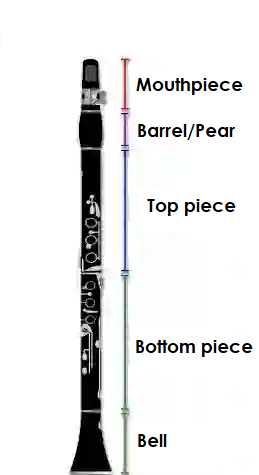Construction and function of the Clarinet - Philipp Dangas
Construction and function of the clarinet
The clarinet is a transposing musical instrument in the woodwind family. It has a predominantly cylindrical bore and is fitted with a single-reed mouthpiece. The body of the clarinet is usually made of grenadilla wood, often boxwood or ebony, instruments made of metal or various plastics are rare.
The key mechanism is usually made of nickel silver, brass, silver or gold. The overall length of the Bb clarinet is approximately 67cm (71cm for the A clarinet) and the inner bore is approximately 13mm wide. For ease of manufacture, transport and maintenance, the clarinet consists of five separate parts that snap together with cork-lined pegs.
The airflow that the musician blows into the instrument causes the reed attached to the mouthpiece to flick back and forth. The resulting double vibration path means that the clarinet sounds almost an octave. lower, even if it is about the same size as a flute. The frequency of this vibration depends on the one hand on the length of the closed air column in the body, which can be changed by opening and closing the tone holes and keys, but on the other hand it is also influenced by the pressure on the lips and the blowing force, with which small corrections in pitch can be made . Because of the cylindrical bore of the clarinet, even-numbered overtones do not sound.
The basic scale of the clarinet is much longer than that of other woodwind instruments, which means that the key system is particularly complicated.
Download size: 857 kilobytes
Table summary of the functional principle of the woodwinds
The following table contains the key data on the functional principle of the woodwinds located. Above all, mouthpieces, reeds, tone holes and flaps briefly described. The term overblowing technique is also described.

The construction of a clarinet in large scale
The components of a clarinet
- Mouthpiece
- Barrel/Pear
- Top piece
- Bottom piece
- Bell
Internal search function
| Name | Value | Delete |
|---|